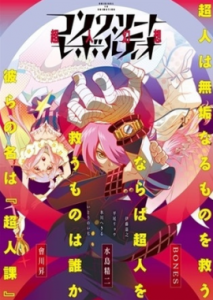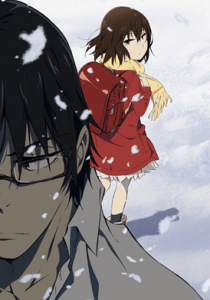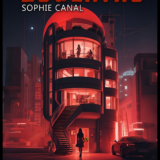Congratulations to everyone reading this on surviving 2016. Amid the trials and tribulations of the year, we did get some pretty awesome anime. Here are my favorites.
For awards voters, I’ll include the studio and primary director and writer credits. (“Series composition” is approximately equivalent to the head writer.) For anime newbies, I’ll add a link to my commentaries for the series, which will contain cultural notes as needed.

#3: Concrete Revolutio
Concrete Revolutio is so many things. It’s a love letter to animated shows of the ’60s and ’70s. It’s an intricately plotted examination of people trying to navigate the social upheaval of the times as an alternate-history postwar Japan comes into its own. It’s a great big wonderful gumbo of every kind of superhero trope mixed up with delight. It has things to say about justice, about freedom, about cultural imperialism, about youth and music and a gazillion other things.
And deep in its core, beneath the dense layers of history and allegory, it’s really about Godzilla rampaging against the nihilism of Watchmen. Sure, the world is complicated, it says, but don’t stop trying. A message we need more than ever now.
Studio: BONES
Director: Seiji Mizushima
Script: Masaki Tsuji, Shou Aikawa
International streams: Daisuki (Worldwide except Japan); FUNimation (US, Canada); ADN (France, Belgium, Luxembourg, Switzerland, Andorra, Monaco); AnimeLab (Australia, New Zealand)
Episode-by-episode commentaries

#2: Mob Psycho 100
A sharp but human parody of paranormal stories and satire of real-life frauds. Mob and Reigen are the most unlikely team: a hyperpowered psychic boy who desperately wants to be anything but that, and his brilliant con man of a mentor, who does such a good job of pretending to be a noble sage and hero that he inadvertently functions as a genuine one.
Mob Psycho 100 is also the most memorable-looking series of the year. Preserving the idiosyncratic style of the source material and embellishing it with a wide variety of effects could have been a recipe for disaster, but somehow it all just works together. It’s as much fun just to look at it as to pay attention to the story.
Studio: BONES
Director: Yuzuru Tachikawa
Series Composition: Hiroshi Seko (source manga by ONE)
International stream: Crunchyroll (worldwide except Asia)
Episode-by-episode commentaries

#1: ERASED
This came straight out of the gate with the best premiere of the winter season and never looked back. 29-year-old Satoru Fujinuma falls back in time to inhabit his grade-school self and race to stop the murders of two of his classmates by a serial killer, who may also have killed Satoru’s mother in the present day. As he realizes the first victim-to-be is already dealing with horrible abuse, it becomes partly a story of reaching out and learning to make personal connections, and partly an intense psychological thriller as Satoru battles an unknown killer. And it is a thriller, not a murder mystery, as the viewer is clearly intended to figure out what’s really going on before Satoru does, and understand the horror of what he’s failing to see.
Aside from being amazingly well-written and directed, ERASED stands out from the pack just with its premise and aim: An adult rather than a teenage protagonist, a setting mostly in Hokkaido rather than the Tokyo area, a present and competent mother rather than a conveniently absent one, a story about learning to be a better adult above and beyond just kicking the butt of evil. I could stand to watch a lot more shows like this.
Studio: A-1 Pictures
Director: Tomohiko Ito
Series Composition: Taku Kishimoto (source manga by Kei Sanbe)
International streams: Crunchyroll (Americas, UK, Ireland, Australia, New Zealand); Daisuki (territories not specified); AnimeLab (Australia, New Zealand); Wakanim (Canada, France, Belgium, Netherlands, Luxembourg, Switzerland, Morocco, Algeria, Tunisia); peppermint anime (Germany, Austria, Switzerland, Luxembourg, Liechtenstein)
Episode-by-episode commentaries
A few other moments that will stick with me:
- Emilia’s speech at the halfway point of Re: ZERO. Not just a beautiful refutation of the Stalker Theory of Romance; in retrospect it feels like the definitive end of anime being willing to support the abusive jerk hero trope.
- Shizuru’s focus episode in BBK/BRNK. No matter how much that show screwed up later on, that was still the best moment for neurodiversity I’ve ever seen in anime.
- Mutant killer bunnies for peace! It’s unfair to Kagewani -II- to pick out that particular bit to represent it, but I will never get tired of saying “mutant killer bunnies for peace”.
- Cheating Craft serving up my new favorite beach episode ever. Which title it claimed even before turning into Sharknado.
Year in review: The look of the 2020s
By my count, this is the 200th consecutive week that I’ve commented on anime for Amazing Stories. When I started back in March 2013, I wanted to stick with it for as long as I had the chance, but there’s still been a little bit of surprise mixed in with the feeling of accomplishment as I put “2017” in the the weekly roundup title for the first time. Here’s to 200 more.
In that time, I’ve seen two big trends up close. One is the arrival and departure of Peak Light Novel, which I have nothing but positive feelings about. It’s fine if we still get an occasional light novel adaptation, especially if it’s as good as Re: ZERO, but I will never dread the arrival of a new season of video game adaptations the way I have dreaded one full of light novel adaptations.
The other, over the past year or so and particularly the last season, has been an overall shift in art styles toward what will make future viewers say, “That looks so 2020s.” There are two easy-to-spot components:
1) Flatter rendering and more fluid-looking motion. A lot less work goes into complex three-dimensional shading or luminous eyes with deep highlights. This is something that happens anyway on productions that have fewer resources, but it can be distinguished as a deliberate choice when the production instead puts time and budget into making sure movements are clean, and bumping up the framerate when that’s an option.
Kill la Kill (from 2014) is probably the first high-profile example, but it’s becoming more common now. Particularly good examples the last couple seasons include Mob Psycho 100 and the premieres of Flip Flappers and Occultic;Nine.
2) More color. Both a wider palette and a brighter, more intense one. This has been especially strong in the last season: Cheating Craft, ClassicaLoid, Matoi the Sacred Slayer, Time Bokan 24, and Flip Flappers. Even Magical Girl Raising Project, sticking mostly to somber colors to match its tone, had an outburst of it for Nemurin’s dream base.
Put these together and you have a move toward a deliberately cartoony look. It’s as though anime is embracing its artificiality, abandoning a pretense of realism to explore the realms of pure art.
Or it could just be what the current generation of animation tools is making it easy to do. Anyway, I think it looks fine.










